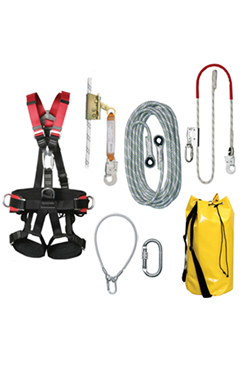The Occupational Safety and Health Administration (OSHA) recently announced the preliminary Top 10 most frequently cited workplace safety violations for the plafiscal year 2018 at the NSC Congress and Expo, the world’s largest annual gathering of safety professionals.

The Top 10 safety violations for FY 2018 are:
Safety violations No of occurrences
| 1. Falling | 7,270 |
| 2. Hazard Communication | 4,552 |
| 3. Scaffolding | 3,336 |
| 4. Respiratory Protection | 3,118 |
| 5. Lockout/Tagout | 2,944 |
| 6. Ladders | 2,812 |
| 7. Powered Industrial Trucks | 2,294 |
| 8. Fall Protection – Training Requirements | 1,982 |
| 9. Machine Guarding | 1,972 |
| 10. Eye and Face Protection | 1,536 |

“Falling” topped the list with 7,270 violations. Looking at the history of accidents, falls are the leading cause of fatalities in construction, accounting for about one-third of all fatalities in the industry. Most common causes of accidents when working at heights are addressed in this article and some tips on how to avoid them are discussed:

1.Fragile Roofs
They are the elevated surfaces that are at risk of falling when under the pressure of unpredicted loads. All roof surfaces should be considered fragile until a competent person has examined it. Examples of Fragile roofing materials include Rooflights and Perspex sheeting (often difficult to identify due to weathering), Liner sheets on built up roofs, Unreinforced cement sheets which includes asbestos cement sheeting, Glass (including wired glass) and Wood wool slabs.
Workers who step or sit on fragile roof materials are at risk of falling or slipping from heights which can lead to a disaster. Also, falling material and equipment can pose critical safety risks to those working below.
Risks can be avoided by
a) Do not undertake any roof work, painting or repairs yourself unless you are competent to do so. Working on fragile and cladded type roofs requires the worker to be competent and in possession of the relevant valid SOLAS Construction Skills Certification Scheme (CSCS) for Roof Cladding.
b) a risk assessment should be conducted before working on roofs to identify fragile roof surfaces and materials.
c) Select the most suitable work equipment for the job. Collective protection must be prioritised over individual protection.
d) Workers should also wear appropriate foot protection or footwear.
e) Carry out the work in a safe manner in accordance with the Health and Safety Authority Code of Practice for Safety in Roof work.
2. Falling Materials
Falling Materials on a worksite can expose workers to relatively minor injuries, such as cuts and abrasions, as well as more serious injuries, such as concussions or blindness. Working beneath scaffolds or other areas where overhead work is being performed lays workers at risk from falling objects. Flying objects such welding particles, wooden particles, etc. become a concern when workers are using power tools or performing tasks that involve pushing, pulling or prying. Even small items can cause considerable damage to people and structures if dropped from a height. Injuries range from bruises to fractures, and even fatalities. Damage to structures can also affect work schedules due to repair work.
The following hazards should be actively identified and controlled in order to lower the risk of falling materials injuring workers:
• Gaps in platform surfaces or between platforms
• Unprotected edges
• Improper transportation of materials, equipment, or tools from ground level to the working area
• Improper transportation methods of getting materials down to ground level, e.g. careless throwing
• Improper storage of materials, e.g. on scaffold edges or in unstable stacks
In addition to these, an adequate warning should be provided to both workers and civilians entering the job site where the risk of falling materials cannot be eliminated. This can be achieved by posting signage, wearing appropriate PPE/ head protection, verbally communicating the hazards, or providing civilian or guest routes to get around the job site. Materials should be stacked securely to prevent them from sliding, falling or collapsing. Always wear hard hats when work is being performed overhead or when other work conditions call for it.

3. Weather Conditions
Weather conditions can affect work surfaces, workers, materials, and equipment.
• Rain or ice can cause workers to slip and fall
• Strong winds can blow loose materials/ tools away, make access equipment unstable, and affect the balance of workers
• Cold conditions may affect workers’ dexterity and increase the risk of injuries
• Overexposure to ultraviolet (UV) rays from the sun can cause cancer, sunburn, and eye problems
According to OSHA regulations, the employers of the workers should provide the necessary safety equipment. The workers should be encouraged to wear equipment suitable for different weather conditions accordingly.
4.Unstable Equipment
Equipment used to access heights such as scaffolding, towers, platforms, and ladders should stable enough to be considered safe. Using unstable equipment puts workers at risk of losing their balance which can lead to falling and dropping materials and hence accidents and injuries.
Though there are inherent risks in using such equipment when working at heights, proper maintenance and use should be observed in order to reduce the risks to acceptable levels. Unstable equipment deemed unsafe by a competent person must not be used.

International labour standards (conventions and recommendations) and the other instruments on occupational safety and health (codes of practice and guidelines) aim at ensuring and promoting a safe and healthy working environment. These standards and codes of practices should be strictly followed to ensure proper safety of the workers.

